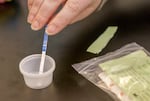
FILE - Blackburn Center peer case manager Lisa Greenfield demonstrantes how to use fentanyl test strips, May 4, 2023. The strips can help identify the presence of fentanyl in the drug being tested, but not the quantity.
Kristyna Wentz-Graff / OPB
“They tried to make me go to rehab, but I said no, no, no!” Amy Winehouse sang in 2006.
In 2023, try: “They tried to make me go to rehab, but I said my family can’t afford a $28,731 deposit to secure my spot.”
A new study from Oregon Health & Science University has examined cost and wait times for residential addiction treatment programs for people aged 18 and younger across the nation, using researchers posing as a teen’s concerned relative.
The study, published Monday in the journal “Health Affairs,” concluded that programs for adolescents are often expensive, and offer limited choices in each state.
It’s the second report from lead author Caroline King on the state of treatment for young people with opioid use disorders, as adolescent use of opioids has climbed during the fentanyl crisis.
Related: Two new residential projects will expand behavioral health and addiction treatment in Portland area
The researchers were unable to find any residential addiction programs for adolescents in 10 states and the District of Columbia.
In 23 states, they could not find an adolescent residential treatment center that accepted Medicaid, the safety net health insurance for low-income people that covers about half of the children in the United States.
Oregon ranks in the middle of the pack for access to treatment for adolescents, by the study’s metrics. It has at least one residential addiction facility that accepts adolescents and accepts Medicaid payment. But it did not have any facilities that took Medicaid and had a bed available when the researchers made their calls.
Ryan Cook, a co-author of the study and an addiction medicine researcher at OHSU, said residential treatment programs are not the only — or even primary — place where families can get care for a child with opioid use disorder. Hospitals, pediatrics clinics and specialty outpatient clinics can also provide treatment.
But residential treatment facilities are a common option parents think of after a crisis like an overdose.
“We wanted to understand what a family would hear, when they were calling for treatment for their child who just had a fentanyl overdose,” Cook said. “We tried to replicate that experience as best as possible.”
Related: Measure 110 forced Oregon to build a new drug addiction services model. Here’s how that’s going
For-profit treatment facilities’ charge triples that of nonprofits’
Using a federal database and Google search results, the researchers identified 354 residential addiction treatment facilities nationwide that said they provided addiction treatment for adolescents.
In late 2022, four of the researchers made repeat calls to the facilities, posing as the aunt or uncle of a 16-year-old who had survived a fentanyl overdose to ask about admission, treatment practices and costs.
Only 160 of the facilities on the list answered the calls and confirmed they served people under 18.
The study found nonprofit residential facilities provided less expensive treatment programs, were much more likely to take patients on Medicaid, and were less likely to have beds available.
Most for-profit facilities had a bed available the same day, while most nonprofit facilities did not. For facilities with a wait list, the average wait for a spot was four weeks.
Related: Nearly half of people using opioids in rural areas were recently incarcerated, study shows
For families paying out of pocket, the average daily cost at for-profits triples that of nonprofits: $1,211 compared to $395, according to the study’s authors.
About half of all facilities required some up-front payment, and the average initial cost was $28,731.
Twenty of the facilities reported they were free or likely free for a patient on Medicaid.
“Only seven states had a facility that accepted Medicaid, had a bed open the same day, and offered buprenorphine,” the authors wrote. Buprenorphine is a medication that can treat withdrawal symptoms and cravings.
Most facilities don’t provide teens with buprenorphine, expert says
The researchers’ methodology was strong, according to Jake Morgan, assistant professor at Boston University’s School of Public Health, who is an expert on opioid treatment and wasn’t involved in the study.
Morgan said parents should take a cautious approach to residential treatment facilities, given the cost and risks.
Most facilities don’t provide teens with buprenorphine. Without stabilizing medication, Morgan said, people leaving residential programs can be at a high risk of overdose immediately after they conclude the program.
“The startup costs that people have to bear, $10,000-20,000, if a program is not offering medication, that is just predatory,” Morgan said.
Related: Washington County converts quarantine beds into recuperative care haven for homeless population
OHSU’s Cook encouraged families looking for opioid use disorder treatment for children to start by having a conversation with their pediatrician, who should know the best local options.
Four Oregon facilities were reviewed as part of the study: NARA, Madrona Recovery, Rimrock Trails Treatment Services, and ADAPT.
More beds may be on the way to the state, however. Last week, Gov. Tina Kotek and Oregon’s Medicaid insurers announced a $25 million investment in residential psychiatric and treatment beds for youth.
